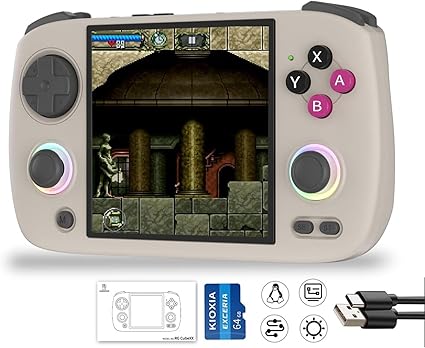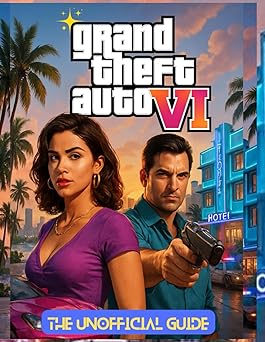
Overview
The RG Cubexx (CubeXX) is a niche retro handheld built around a square 1:1 aspect ratio screen (3.95″ IPS, 720×720) with a Linux-based system. It is marketed as a retro gaming device capable of emulating classic consoles and offering features like WiFi, Bluetooth, online play, and streaming support. It may also ship (or be sold) in variants with a 64 GB card preloaded with thousands of games (though legality of that is a separate issue). The hardware sits in the low-to-mid range of current retro handhelds.
Many reviews emphasize that this device is meant for enthusiasts of square-screen (1:1) gaming experiences, such as Game Boy, Game Boy Color, Game Boy Advance (with letterboxing or scaling), Pico-8, and vertical arcade shooters. The unusual aspect ratio is both its biggest selling point and its limiting factor.
Let’s dig deeper into each aspect.
Design & Build Quality
Form factor & ergonomics
The CubeXX maintains the “cube” aesthetic (relatively square) but incorporates grips on the back so you can still hold it in a more traditional handheld posture. Reports suggest that the grips help reduce hand fatigue, and many users note that it is lighter than some of its siblings in the Anbernic H700 lineup. Reviewers note that the ergonomics are “excellent,” squashing one of the major criticisms of square-screen designs.
However, because the screen is square, supporting 4:3 or 16:9 games means you’ll often get black bars or scaling adjustments, which may feel odd in some titles.
Materials & finish
The shell is typical retro-handheld plastic: solid enough for day-to-day use, but not premium. Buttons and D-pad are generally well regarded. The D-pad is styled in a “Sega-like” shape in many reviews, and users report it is accurate and comfortable for retro titles. The shoulder buttons and triggers are adequate for the class, though not exceptional.
One decorative flourish is the RGB joystick lighting ring, with support for multiple modes (steady, breathing, chasing, etc.). That adds a flair of flair (pun intended), though it doesn’t affect gameplay.
Overall, build quality is respectable for its price range—nothing luxurious, but solid and functional.
Display
Specs
-
3.95-inch IPS panel
-
720 × 720 resolution
-
OCA full lamination for better visual clarity
The square, 720×720 resolution is what defines this device. It isn’t high by modern gaming standards, but it is sharp enough for retro titles. The full lamination helps reduce internal reflections and improves contrast.
Visual experience
For games originally designed for square or vertical formats (e.g. Game Boy, Game Boy Color, Pico-8, vertical shooters), the Cubexx shines. Titles that map naturally to square layout look very clean. For 4:3 or 16:9 titles, you’ll see either black bars (letterboxing or pillarboxing) or scaling or cropping, depending on emulator settings or user preferences.
Reviews frequently praise how excellent Game Boy, GBC, and Pico-8 games look on this display. However, the compromises in other aspect ratios are unavoidable with a square screen.
Brightness, color, and viewing angles are adequate for indoor use. Outdoors or under strong light, readability drops, but that’s common in this category of device.
Hardware & Performance
Core hardware
-
CPU: Allwinner H700, quad-core ARM Cortex-A53 (~1.5 GHz)
-
GPU: Dual-core G31 MP2
-
RAM: 1 GB LPDDR4
-
Storage: Ships with (or supports) 64 GB microSD / TF card (can expand)
-
Battery: 3,800 mAh
-
Connectivity: 2.4G/5G WiFi (802.11 a/b/g/n/ac), Bluetooth 4.2
-
Output: HDMI / TV out support, wired/wireless controllers, vibration motor
This hardware is similar to other budget Linux-based retro handhelds in the H700 class. It is not a powerful chip by modern mobile or gaming standards, but it is well-suited to retro emulation up to a point.
Emulation & performance
In practice, the Cubexx handles simpler systems (NES, SNES, Game Boy, GBA, Sega Genesis / Mega Drive, Game Boy Advance) very competently at full speed. Many users report that it handles DS, PSP, Dreamcast, and Nintendo 64 titles with varying success depending on the game, config, and frame skip settings. Some titles may require adjusting settings or accept compromises (frame drops, lower resolution).
Because of the square screen, some games may need custom scaling or cropping to play well visually. The community has been developing custom firmware (e.g. Knulli builds) to better optimize for the 1:1 form factor.
Reviewers note occasional limitations: heavy 3D games or more demanding titles (e.g. certain PSP or Dreamcast games) will push the hardware and may suffer.
All told, the RG Cubexx delivers solid performance for many classic consoles, but is not flawless for every title above PS1/N64 territory.
Software, OS & Interface
Stock system
The device ships with a Linux-based front end (often with EmuElec or a custom interface). This allows for multiple emulators, file management, video playback, music, and possibly streaming features. The UI is serviceable, though not always polished compared to higher-end systems.
Custom firmware & community
A strong point is the community support. Custom firmware (CFW) efforts like muOS or Knulli are being developed to improve performance, UI experience, and 1:1 aspect handling. Some users report that newer builds add features or improved support for emulators.
One caveat: certain features (e.g. Bluetooth) may not be fully supported in all custom firmware at launch, so if you rely on wireless controllers, the stock firmware might be safer initially.
Features & extras
-
WiFi enables online multiplayer, ROM download (if allowed), OTA updates, and possibly retro-achievements.
-
Bluetooth allows pairing of external controllers or headsets (depending on firmware support).
-
HDMI/TV output: you can connect the device to a larger screen for a console-like experience.
-
Video and music playback: it supports common video and audio formats, making it useful as a media player in addition to gaming.
-
Lighting customization: you can adjust or disable RGB effects to conserve battery.
The software stack is flexible, and power users will appreciate the ability to tinker, though novices may face a slight learning curve.
Battery & Power
With its 3,800 mAh battery, real-world runtime is about 5 to 7 hours depending on usage (game type, brightness, WiFi on, etc.). Some users report around 6.5 hours under favorable conditions.
Charging is via USB-C with support for typical 5 V/1.5 A charging. There is no fast-charging support.
For most retro sessions, the battery life is reasonable. But for heavy 3D emulation, streaming, or high brightness, you’ll see shorter times.
Connectivity, Streaming & Online Use
One of the selling points is support for 5G WiFi (i.e. 5 GHz) and Bluetooth, which helps with smoother streaming, quicker downloads, and wireless peripherals.
In practices:
-
Streaming: With stable WiFi, you can use online streaming of titles (depending on the software), or possibly cloud/remote streaming. The 5 GHz support helps reduce latency and buffering.
-
Online multiplayer: The WiFi stack allows connecting with others or using features like retro-achievements or ROM sharing (within legal limits).
-
Bluetooth: You can pair external controllers or audio devices (but again, whether this works depends on firmware support).
-
TV output: You can output to a TV via HDMI or related options, turning your handheld into a console-like device on a larger screen.
These features elevate the device beyond being just another emulator box — you can integrate it with modern connectivity.
Strengths & Highlights
-
Unique 1:1 screen niche: For games that fit square or vertical formats, the Cubexx delivers a visual experience few other handhelds can match.
-
Strong retro performance for classic systems: It handles 8-bit and 16-bit consoles with ease.
-
Good feature set: WiFi, Bluetooth, TV output, RGB lighting, and more make it a well-rounded package.
-
Excellent value: Compared to many higher-cost retro handhelds, the performance-to-price ratio is a major draw.
Weaknesses & Limitations
-
Not ideal for heavy 3D titles: Demanding PSP, Dreamcast, or N64 games may suffer from frame drops or require aggressive configuration.
-
Aspect ratio tradeoffs: 4:3 and 16:9 games are not native to the display, and scaling or black bars are inevitable.
-
RAM limitation: Only 1 GB of RAM limits more sophisticated tasks or multiple concurrent processes.
-
Battery life is average: Good for its class, but not exceptional.
-
Firmware maturity: Some custom builds may lack full support for all features (e.g. Bluetooth) initially.
-
Legality & “preloaded games” concern: While many sellers indicate preloaded game lists (e.g. 5,000+ or 5,373 games), distribution of copyrighted ROMs may violate laws in many jurisdictions. It’s safer to use your own legally obtained ROMs and homebrew.
Use Cases & Who Should Buy It
This device is best for:
-
Retro handheld enthusiasts who want something unique in display and form factor.
-
Fans of Game Boy / square / vertical formats who want native support.
-
Tinkerers and modders who enjoy installing custom firmware and optimizing experience.
-
Casual retro gamers who primarily play 8- to 16-bit console games and don’t require perfect performance on heavier systems.
It is less ideal for:
-
Gamers who want to emulate modern or high-performance systems (e.g. PS2, Wii, GameCube) at high fidelity.
-
Those who want plug-and-play simplicity without learning firmware/flashing.
Final Verdict
The RG Cubexx / RG CubeXX is a distinctive handheld that leans into a niche: square-screen retro gaming. It succeeds in that niche better than most rivals. If your library is heavy on Game Boy, vertical shooters, Pico-8, and classic 8/16-bit consoles, the visual payoff is very satisfying.
Hardware-wise, it’s not cutting-edge, but it’s well-chosen for its intended audience. The tradeoffs—especially when running more demanding emulation—are real, but acceptable in context. The strong community backing and firmware options add long-term viability.
If you go in understanding its constraints and embrace the quirks of square-screen gaming, the Cubexx can be a beloved addition to your retro hardware collection.








